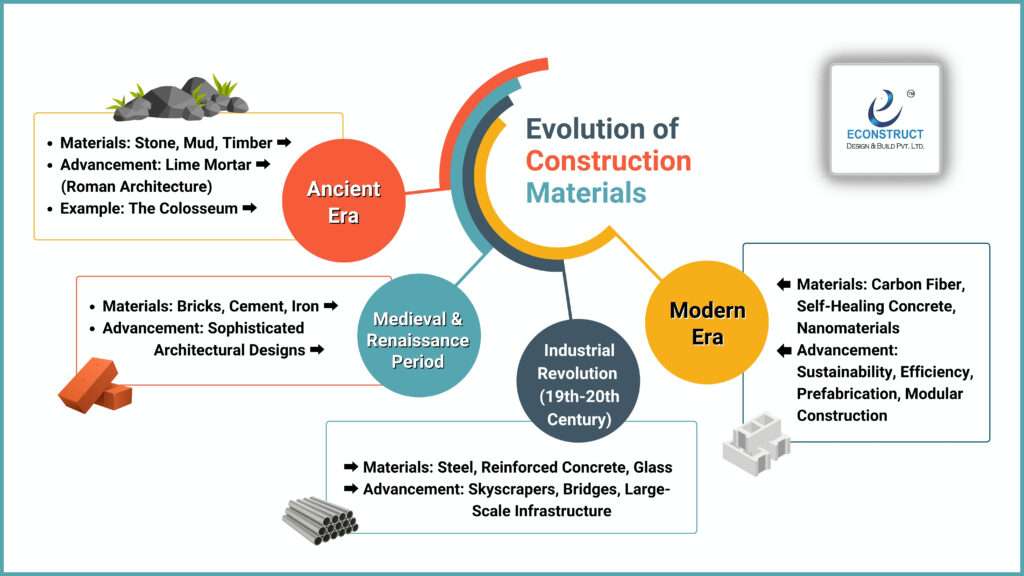The Evolution of Modern-Day Construction Men, Material, and Machine

The Evolution of Modern-Day Construction: Men, Material, and Machine
Construction has evolved drastically from ancient times to modern-day practices. With advancements in technology, the methods of building structures have transformed, improving efficiency, safety, and sustainability. This evolution can be precisely understood through three major factors: Men (Workforce), Material, and Machine.
1. The Evolution of Workforce (Men)
In ancient civilizations like Mesopotamia, Egypt, and Rome, construction was predominantly labor-intensive. Skilled artisans and unskilled workers manually carved stones, laid bricks, and constructed massive monuments, relying solely on physical labor. The absence of machinery meant that structures like the Pyramids of Egypt and the Great Wall of China required thousands of laborers working in extreme conditions.
With industrialization, mechanization reduced dependency on manual labor. The modern construction workforce is highly specialized, with engineers, architects, and project managers leading projects alongside skilled technicians operating advanced machinery. The role of AI, automation, and Building Information Modeling (BIM) further enhances precision and efficiency.
2. The Evolution of Materials
Key Lessons from the Collapse
- Ancient Era: The earliest construction materials included stone, mud, and timber. The use of lime mortar in Roman architecture enabled the construction of enduring structures like the Colosseum.
- Medieval and Renaissance Period: The introduction of bricks, cement, and iron allowed for more sophisticated architectural designs.
- Industrial Revolution: The 19th and 20th centuries saw the rise of steel, reinforced concrete, and glass, enabling the construction of skyscrapers, bridges, and large-scale infrastructure.
- Modern Era: Today, materials like carbon fiber, self-healing concrete, and nanomaterials contribute to sustainability and efficiency. Prefabricated and modular construction materials further reduce time and costs while enhancing quality.

3. The Evolution of Machinery
- Pre-Industrial Age: Ancient builders used wooden scaffolding, pulleys, and levers to lift materials manually.
- Industrial Revolution: Steam engines and cranes revolutionized construction, making it faster and more efficient.
- 20th Century: The introduction of heavy machinery like bulldozers, concrete mixers, and tower cranes accelerated large-scale projects.
- 21st Century: Today, robotics, drones, and AI-powered construction equipment minimize human intervention, increase precision, and enhance safety. 3D printing and automation are paving the way for futuristic, rapid construction methodologies.
Conclusion:
The evolution of construction through Men, Material, and Machine has transformed the industry from labor-intensive methods to highly automated and technologically driven processes. The future of construction is expected to see further advancements in smart materials, AI integration, and sustainable practices, leading to more efficient and eco-friendly developments worldwide.
Modern-day construction stands as a testament to human ingenuity, shaping the built environment with innovative materials, cutting-edge machinery, and a skilled workforce ready to embrace the next wave of advancements.
At Econstruct, we continuously integrate the latest technological advancements to optimize construction processes, enhance efficiency, and deliver high-quality structural solutions. Below are some of the key technologies we leverage for simplified and effective construction practices:
1. ePMC – A Smart Construction Management Solution
ePMC (Econstruct Project Management & Collaboration Tool) is a robust, AI-driven construction project management system designed to streamline workflows, improve resource allocation, and ensure seamless coordination across all project phases.
2. In House AI Based Tools
Econstruct has developed custom AI-driven tools to automate complex engineering calculations, optimize structural designs, and enhance predictive analysis
3. Emerging Software Tools in Structural Engineering
We incorporate the latest software solutions for structural analysis, BIM modeling, and construction management, including
4. Third-Party Integration for Enhanced Capabilities
To further enhance efficiency, we integrate third-party AI, BIM, and cloud-based solutions, ensuring seamless interoperability and project execution
The Future of Construction at Econstruct
By embracing automation, AI-driven solutions, and digital transformation, Econstruct is redefining modern construction practices. Our technology-driven approach ensures precision, cost efficiency, sustainability, and faster project execution, setting new benchmarks in the industry.


